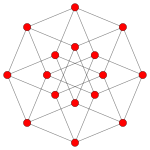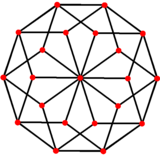Loading AI tools
In five-dimensional geometry, a 5-cube is a name for a five-dimensional hypercube with 32 vertices, 80 edges, 80 square faces, 40 cubic cells, and 10 tesseract 4-faces.
| 5-cube penteract (pent) | ||
|---|---|---|
| Type | uniform 5-polytope | |
| Schläfli symbol | {4,3,3,3} | |
| Coxeter diagram | ||
| 4-faces | 10 | tesseracts |
| Cells | 40 | cubes |
| Faces | 80 | squares |
| Edges | 80 | |
| Vertices | 32 | |
| Vertex figure |  5-cell | |
| Coxeter group | B5, [4,33], order 3840 | |
| Dual | 5-orthoplex | |
| Base point | (1,1,1,1,1,1) | |
| Circumradius | sqrt(5)/2 = 1.118034 | |
| Properties | convex, isogonal regular, Hanner polytope | |
It is represented by Schläfli symbol {4,3,3,3} or {4,33}, constructed as 3 tesseracts, {4,3,3}, around each cubic ridge.
It is a part of an infinite hypercube family. The dual of a 5-cube is the 5-orthoplex, of the infinite family of orthoplexes.
Applying an alternation operation, deleting alternating vertices of the 5-cube, creates another uniform 5-polytope, called a 5-demicube, which is also part of an infinite family called the demihypercubes.
The 5-cube can be seen as an order-3 tesseractic honeycomb on a 4-sphere. It is related to the Euclidean 4-space (order-4) tesseractic honeycomb and paracompact hyperbolic honeycomb order-5 tesseractic honeycomb.
This configuration matrix represents the 5-cube. The rows and columns correspond to vertices, edges, faces, cells, and 4-faces. The diagonal numbers say how many of each element occur in the whole 5-cube. The nondiagonal numbers say how many of the column's element occur in or at the row's element.[1][2]
The Cartesian coordinates of the vertices of a 5-cube centered at the origin and having edge length 2 are
- (±1,±1,±1,±1,±1),
while this 5-cube's interior consists of all points (x0, x1, x2, x3, x4) with -1 < xi < 1 for all i.
n-cube Coxeter plane projections in the Bk Coxeter groups project into k-cube graphs, with power of two vertices overlapping in the projective graphs.
| Coxeter plane | B5 | B4 / D5 | B3 / D4 / A2 |
|---|---|---|---|
| Graph |  |
 |
 |
| Dihedral symmetry | [10] | [8] | [6] |
| Coxeter plane | Other | B2 | A3 |
| Graph |  |
 |
 |
| Dihedral symmetry | [2] | [4] | [4] |
 Wireframe skew direction |
 B5 Coxeter plane |
 Vertex-edge graph. |
 A perspective projection 3D to 2D of stereographic projection 4D to 3D of Schlegel diagram 5D to 4D. |
 4D net of the 5-cube, perspective projected into 3D. |
The 5-cube can be projected down to 3 dimensions with a rhombic icosahedron envelope. There are 22 exterior vertices, and 10 interior vertices. The 10 interior vertices have the convex hull of a pentagonal antiprism. The 80 edges project into 40 external edges and 40 internal ones. The 40 cubes project into golden rhombohedra which can be used to dissect the rhombic icosahedron. The projection vectors are u = {1, φ, 0, -1, φ}, v = {φ, 0, 1, φ, 0}, w = {0, 1, φ, 0, -1}, where φ is the golden ratio, .
It is also possible to project penteracts into three-dimensional space, similarly to projecting a cube into two-dimensional space.
 A 3D perspective projection of a penteract undergoing a simple rotation about the W1-W2 orthogonal plane A 3D perspective projection of a penteract undergoing a simple rotation about the W1-W2 orthogonal plane |
 A 3D perspective projection of a penteract undergoing a double rotation about the X-W1 and Z-W2 orthogonal planes A 3D perspective projection of a penteract undergoing a double rotation about the X-W1 and Z-W2 orthogonal planes |
The 5-cube has Coxeter group symmetry B5, abstract structure , order 3840, containing 25 hyperplanes of reflection. The Schläfli symbol for the 5-cube, {4,3,3,3}, matches the Coxeter notation symmetry [4,3,3,3].
Prisms
All hypercubes have lower symmetry forms constructed as prisms. The 5-cube has 7 prismatic forms from the lowest 5-orthotope, { }5, and upwards as orthogonal edges are constrained to be of equal length. The vertices in a prism are equal to the product of the vertices in the elements. The edges of a prism can be partitioned into the number of edges in an element times the number of vertices in all the other elements.
| Description | Schläfli symbol | Coxeter-Dynkin diagram | Vertices | Edges | Coxeter notation Symmetry | Order |
|---|---|---|---|---|---|---|
| 5-cube | {4,3,3,3} | 32 | 80 | [4,3,3,3] | 3840 | |
| tesseractic prism | {4,3,3}×{ } | 16×2 = 32 | 64 + 16 = 80 | [4,3,3,2] | 768 | |
| cube-square duoprism | {4,3}×{4} | 8×4 = 32 | 48 + 32 = 80 | [4,3,2,4] | 384 | |
| cube-rectangle duoprism | {4,3}×{ }2 | 8×22 = 32 | 48 + 2×16 = 80 | [4,3,2,2] | 192 | |
| square-square duoprism prism | {4}2×{ } | 42×2 = 32 | 2×32 + 16 = 80 | [4,2,4,2] | 128 | |
| square-rectangular parallelepiped duoprism | {4}×{ }3 | 4×23 = 32 | 32 + 3×16 = 80 | [4,2,2,2] | 64 | |
| 5-orthotope | { }5 | 25 = 32 | 5×16 = 80 | [2,2,2,2] | 32 |
The 5-cube is 5th in a series of hypercube:
 |
 |
 |
 |
 |
 |
 |
 |
 |
 |
| Line segment | Square | Cube | 4-cube | 5-cube | 6-cube | 7-cube | 8-cube | 9-cube | 10-cube |
The regular skew polyhedron {4,5| 4} can be realized within the 5-cube, with its 32 vertices, 80 edges, and 40 square faces, and the other 40 square faces of the 5-cube become square holes.
This polytope is one of 31 uniform 5-polytopes generated from the regular 5-cube or 5-orthoplex.
Wikiwand in your browser!
Seamless Wikipedia browsing. On steroids.
Every time you click a link to Wikipedia, Wiktionary or Wikiquote in your browser's search results, it will show the modern Wikiwand interface.
Wikiwand extension is a five stars, simple, with minimum permission required to keep your browsing private, safe and transparent.




































